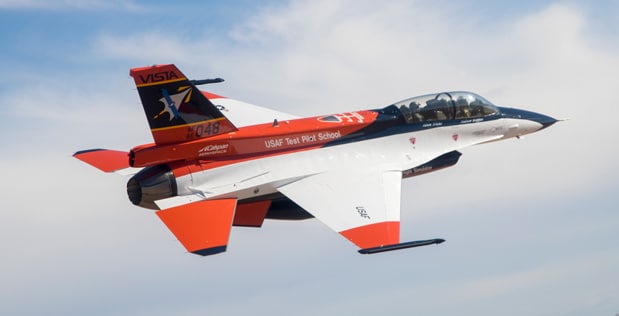Aviation
DARPA’s AI-piloted F-16 completes first flight testing program

– The US Air Force is prepared to fly pilot-less aircraft in the upcoming year’s thanks to DARPA’s development of the newest artificial intelligence technology that will aid in operations.
-In less than three years, algorithms for artificial intelligence (AI) created as part of DARPA’s Air Combat Evolution (ACE) program have advanced from commanding virtual F-16s engaged in aerial dogfights on computer screens to commanding a real F-16 in flight.
-The F-16 was updated and converted to a brand-new design that became known as the X-62A Variable In-flight Simulation Test Aircraft, or VISTA. An AI agent recently piloted it for more than 17 hours, marking the first time AI had operated a tactical aircraft.
-The first autonomous Black hawk helicopter demonstration flight was carried out by the US army last October. It was able to operate the unmanned Black Hawk chopper on its own and was safe and reliable for performing rescue missions as well as internal and external cargo replenishment flights. This technology, in particular, may be used in contested or limited visibility settings, giving Army commanders and aviators more options in how and when to use aircraft and pilots.
In an effort to significantly increase the efficiency and safety of rotary and fixed-wing aircraft, Sikorsky and DARPA are collaborating to develop autonomy technology. Aircrew Labor In-cockpit Automation System, a DARPA project, is built around Sikorsky’s autonomy system, also known as MATRIX™ technology.
-The Air Force Test Pilot School (TPS) at Edwards Air Force Base in California is where the F-16 flew numerous times over the course of several days, as per DARPA. According to a US military research organization, the flights successfully showed that AI agents can manage a full-scale fighter jet and offer live-flight data.
The ACE AI flights were part of a successful broader test event including DARPA, TPS, and the Air Force Research Laboratory, enabling multiple Defense Department organizations to work closely together with AI development contractors toward shared objectives.
Finnair Reveals Summer Schedule With 50+ European Destinations(Opens in a new browser tab)
-DARPA performers EpiSci, PhysicsAI, Shield AI, and the Johns Hopkins Applied Physics Laboratory flew different F-16 AI algorithms on the X-62A. The aircraft, a highly modified two-seat F-16, can be programmed to demonstrate the flight-handling characteristics of a variety of different aircraft types. VISTA was upgraded recently with the System for Autonomous Control of Simulation (SACS), making the aircraft a perfect platform to test ACE’s autonomous F-16 AI agents.
-The two-seat L-29 jets at OPL are outfitted with sensors in the cockpit to measure pilot physiological responses, giving researchers clues as to whether the pilot is trusting the AI or not. The TPS recently hosted an ACE Trust Capstone event in late January 2023 using simulators to gauge pilot-agent alignment with follow-on trust-calibration flights in the X-62A planned for later this year.

Aviation
Boeing, Antonov to Collaborate on Defense Projects

– MOU represents Boeing’s commitment to work with Ukrainian industry
– Includes exploring opportunities for collaborating on in-country support of Unmanned Aerial Systems
A Memorandum of Understanding was signed today by Boeing and Antonov Company to investigate potential collaboration on defense-related projects.
“We’re happy to keep collaborating with the Antonov Company to help Ukraine’s economic development and expansion,” stated Ted Colbert, CEO and president of Boeing Defence, Space, & Security.
Airbus and the Antonov An-225: The Best Partnership:Click here
“This agreement demonstrates our ongoing efforts to find more opportunities to work with Ukrainian industry, which was underscored by our signing of the Ukrainian Defence Industry Compact earlier this year.”
The areas of potential collaboration identified in the agreement consist of training, logistical support and overhaul services for tactical Unmanned Aerial Systems utilized by the Ukrainian Armed Forces, which includes the ScanEagle. In addition, the companies will also explore opportunities for Antonov to provide engineering support to Boeing.
The six largest cargo aircraft ever built in the aviation industry:Click here
“A strong, innovative, and efficient defense industry is key to sustainable economic development and national security, and we are extremely excited to collaborate with Boeing,” said Ievhen Gavrylov, CEO of Antonov Company.
This agreement brings a whole new level of opportunity to implement the latest and most effective solutions – in addition to the possibility of future projects with Boeing in the aerospace and defense industry.”
-

 Travel1 week ago
Travel1 week agoAir India to Expand US Operations with Three New Routes After a Decade
-

 Travel2 weeks ago
Travel2 weeks agoWhy We Should Avoid These Stamps in a Passport
-

 Airlines1 month ago
Airlines1 month agoInvestigations Reveal Fake Chinese Titanium in Boeing and Airbus Jets
-

 Tech4 weeks ago
Tech4 weeks agoChina’s CATL Plans 1,800-Mile Electric Plane Launch by 2027
-

 Airport3 days ago
Airport3 days agoTop 10 Largest Airports in the World by Size
-

 Aerospace4 weeks ago
Aerospace4 weeks agoChina’s Fighter Jets Turn Wings into Autonomous Drones
-

 Airlines4 days ago
Airlines4 days agoAir India Rolls Out A350s for Delhi-New York JFK and Newark Routes
-

 Defence3 weeks ago
Defence3 weeks agoBoeing Enhances Chinook with New Engines and Block II Upgrades at $96 Million







